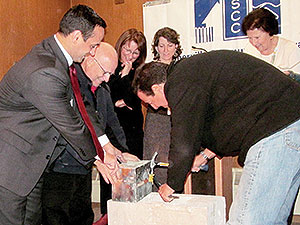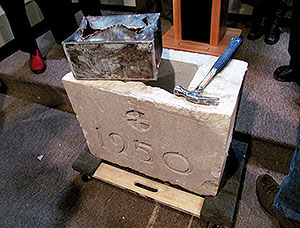
Left to right: Mayor Joseph Curtatone, David Pignone and Sal Querusio work to open a time capsule removed from the cornerstone of the former Saint Polycarp School. Looking on are Ursula Salerno, Meridith Levy and Camille Long. – Photo by Elizabeth Sheeran
Somerville opens St. Polycarp time capsule
*
By Elizabeth Sheeran
Camille Amato Long remembers the day in third grade when all the students lined up to sign their names. It was 1951. Harry Truman was in the White House. Ted Williams was playing for the Red Sox. And at Saint Polycarp Catholic School in Somerville, Long and her fellow classmates were committing their names to posterity, in a time capsule placed in the cornerstone of the newly opened school.
Little did she know she’d be there to see the time capsule re-opened over sixty years later, when the old school building along Mystic Avenue was demolished to make way for affordable housing.
“I don’t think I gave it another thought until I drove by and saw the signs that the school was being torn down, and I thought, ‘Oh no, the time capsule,’” said Long.
The Boston Roman Catholic Archdiocese closed Saint Polycarp Parish in 2002, and in 2006 the non-profit Somerville Community Corporation (SCC) acquired the property with a plan to redevelop the 3.5-acre site as Saint Polycarp Village, with a mix of uses that include 84 affordable housing units.
When Long first noticed the construction signs a few years ago, she picked up the phone and called the builders to tell them about the time capsule. Her campaign eventually led her to the SCC, who worked to keep her in the loop, along with other Saint Polycarp students from the 1950s who had begun to re-connect over their fondness for the old school that was soon to disappear.
As the school building was finally demolished last month to make way for the third and final phase of the new development, local tradesmen carefully removed the cornerstone, with the time capsule still intact, to be opened at the Phase Three groundbreaking ceremony on February 25.
“We always love coming to groundbreakings and ribbon-cuttings, but today’s event has a special significance because it ties our past with our present and our future,” said Mayor Joseph Curtatone, referring not only to the Saint Polycarp School memories and the time capsule about to be opened, but to the 31 new homes to be built on the site of the old school.
“I want to thank you for passing on an incredible legacy, because the new families feel the same way about this community that you do,” said Mayor Curtatone to former students who attended the groundbreaking, along with numerous public officials, project sponsors, and siblings, children and grandchildren of alumni. “The new families that will move into these units will be connected with all of us in a very special way,” said the Mayor.
The Saint Polycarp alumni had a chance to reminisce about their schooldays, recalling Sister Georgina and her clicker, handsome Father Donovan with the blue eyes, and Monsignor Garrity, who was most concerned about the conduct and deportment grade. They shared fond memories of having 65 students to a class, of using the street as a playground, of saying the Hail Mary every time a fire truck went by, and of walking all the way home and back for lunch, no matter the weather.

This metal box was inserted into the cornerstone of the former Saint Polycarp School, where it remained for over 60 years until the building was recently demolished. The 1950 date marks the year the cornerstone was laid.
– Photo by Elizabeth Sheeran
They all said they were sad to see the school go, but thankful the time capsule had given them a chance to recognize how much it had meant to them. David Pignone pointed out that along with First Communions and Confirmations, most of them had also been married at Saint Polycarp.
“Today I have a lot of mixed emotions. Sadness. I’m going to be 71 and I hate to let things go,” said Theresa Pappalarda Finnegan, who credited the nuns at Saint Polycarp with teaching them well. “We have a strong foundation that I brought up through life with me,” said Finnegan.
But apart from the students’ names, none of them had any idea what was inside the time capsule itself. Long, who was wearing her blue and yellow “Saint Polycarp Class of 1956” ribbons for the occasion, said she hoped there would be a newspaper. Her lifelong friend Carol Lanzoni Giordano thought there might be an old 45 record. Pignone joked they might find a meatball sandwich.
With a hammer and crowbar, Pignone and fellow alumnus John Burns took the first crack at trying to extract the metal box from the cornerstone, where it had remained tightly wedged for over six decades. They were soon joined by Mayor Curtatone and local contractor Sal Querusio, who wrenched it free and pried it open.
Roughly 11 inches long, and about four to five inches high and wide, the box appears to have been made of copper and welded shut. Inside, there was no meatball sandwich, nor a vinyl disc. Rather, the capsule held items important to Saint Polycarp at the time: A four-page typed history of the parish. An assortment of religious medallions. Photos of Pope Pius XII and of Archbishop (later Cardinal) Cushing, who had dedicated the school. And reunion programs, sponsored by such enterprises as Suffolk Downs.
There was indeed a newspaper: the May 12, 1951 edition of The Pilot, the official newspaper of the Boston Archdiocese. Maybe not The Boston Globe, but the paper still reflects the times as they were then, at the outset of the Cold War, with headlines like “Bay State Priest Seized by Reds Seen In Prison,” and news of a directive in Czechoslavakia that “Warns Priests Against Red Regime’s Wily Propaganda.”
And there were the names, just as the alumni had remembered them: An envelope for each class, filled with small pieces of paper, each with a carefully penned signature. As former students read out the names, one by one, there were murmurs of recognition.
Carol Giordano said she could remember all but four of her more than 60 classmates. She found her own name and her brother’s, and took a good long look at each before she put them back in the hands of the SCC, which will work with the Somerville Historical Commission to decide on a permanent home for the capsule’s contents.
Said Giordano, “It’s a nice memory. It’s a lot of years. And you don’t think of that when you’re in the third grade, that you’re going to be at this kind of an event.”















Reader Comments